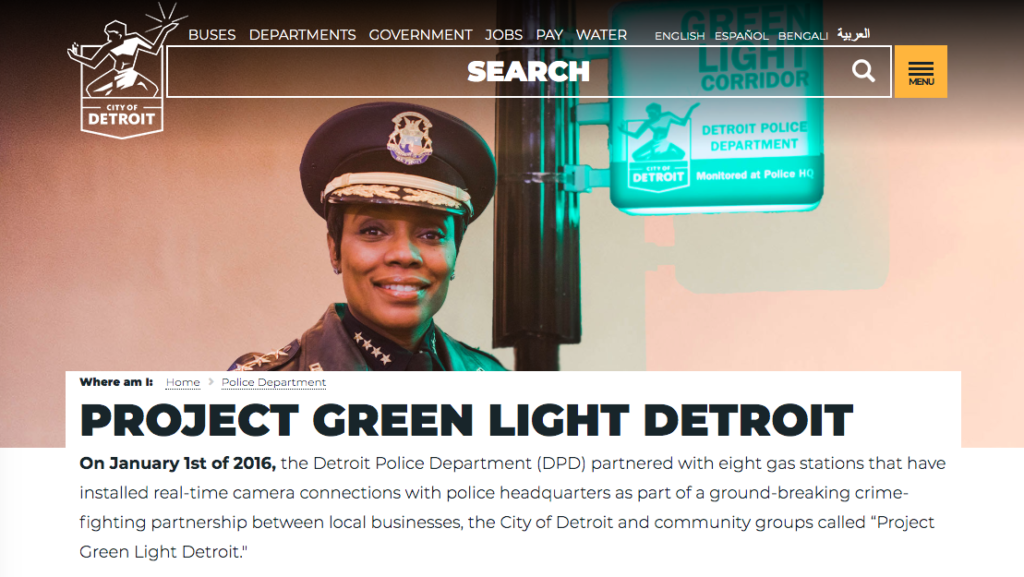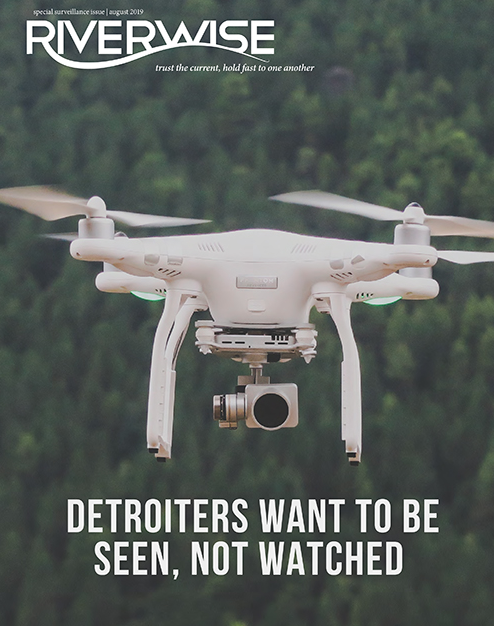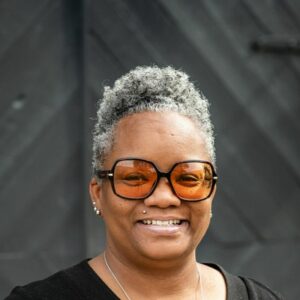ODB Spotlight: Tawana Petty and Facial Recognition Resistance in Detroit
Kim M Reynolds spoke with Tawana Petty to learn more about the anti-surveillance work going on in Detroit, which is currently one of the national spotlights for resistance against facial recognition technology.
Can you briefly introduce yourself and the work you do?
My name is Tawana Petty, and I’m also known as Honeycomb. I am a mother, organizer, author, and poet. I serve in many capacities in Detroit. I serve on the board of the James and Grace Lee Boggs Center to Nurture Community Leadership or Boggs Center for short. I am also a convening member of the Detroit Digital Justice Coalition, so I convene the Detroit Digital Justice Coalition through my capacity as director of data justice for Detroit Community Technology Project (DCTP). I also run an art organization called Petty Propolis, where I organize regular workshops and host an annual art festival and I also teach anti-racism workshops.
What is project Green Light?

“Project Green Light now currently has close to 600 cameras around the city. They started off with about six to nine cameras when they were first promoting the program in 2016 and they’ve rapidly increased that to close to 600 in 2019. They’ve now added traffic lights and various other methods including mobile devices to Project Green Light.”
Project Green Light was being marketed as a public-private partnership between Detroit police, Guardian Alarm Company, local businesses, and willing community members. The police department has these flashing green lights and surveillance cameras placed on commercial businesses and low income housing and at this point now, schools where they 24-hour surveil these locations under the guise of safety, public safety. Now the police department has also been afforded the rights, even though they were doing it for two years without telling anyone, to leverage the footage and photos of Project Green Light for facial recognition identification. So they can extract those images and that footage and put it into their facial recognition system in order to pursue folks that they think are guilty of a crime. In addition to that, in Michigan and many other states, we learned that since 1998 I believe, at least for 17 or 18 years, Michigan state police has put every single ID, state ID, or driver’s license that’s come through secretary of state police into their facial recognition database. So Detroit police also has access to millions of photos of people all over Michigan who have taken IDs just to get a driver’s license or get an ID. And so Project Green Light now currently has close to 600 cameras around the city. They started off with about six to nine cameras when they were first promoting the program in 2016 and they’ve rapidly increased that to close to 600 in 2019. They’ve now added traffic lights and various other methods including mobile devices to Project Green Light.
We know with surveillance that it is not necessarily out of the sky. What is the infrastructure that has allowed this to happen?
Well, I live in Detroit which is predominantly Black… 80 percent Black. At some point, it was 90 percent Black. And one of the consequences of living in a predominantly Black city is that the narrative is inherently that wherever Black folks congregate is dangerous. And so we’ve pretty much experienced a media assault and a propaganda campaign for about a half century in Detroit.
Sometimes, when you’ve been under that type of scrutiny for so long… I’ll use young people as an example. If you are 20 years-old, and your entire life you’ve been told that you’re dangerous, helpless, hopeless, incapable of this, not gonna graduate… various negative narratives around your identity and who you are as a human being, sometimes you escape that, and it doesn’t impact you psychologically or behaviorally. But a lot of times, you don’t escape that. So… we have some situations… [where] people… might be engaging in behavior that is not attributed to the better part of their humanity. We have a lot of quality-of-life crimes because of major disinvestment in the city. The median income here is $26,000 a year. Low-income housing salary starts at forty-something thousand dollars a year. So you have a lot of people in insecure housing or no housing at all. Or they’re being forced to squat in dilapidated properties. Or their water has been turned off, because they can’t afford to pay.
The city consistently invests in things that are the opposite of safety and call[s] them safety… [W]e are constantly pushing back against [this]. And we believe that narrative work is the most important aspect of that so that folks can be re-spirited and understand that as one of my comrades would say, “It’s not your fault, but it is your fight.” We understand a root cause analysis which is why we can’t continue to buy into the fact that our community members are inherently unsafe.
What are the major repercussions of the implementation of facial recognition technology?
Just to paint a little bit of a picture, the [Detroit] Police Department have what are called real-time crime centers. They’re these big rooms full of screens with cameras all over the city that capture every aspect of every person’s life who passes by them. So if you are a domestic violence survivor or if you’re trying to run from a sexual assault or you have AIDS and you’re going to an HIV clinic… there are just a number of things that people don’t deserve to have broadcasted.
You also have non-law enforcement officers, which they call data analysts that are watching these screens as well. And so you have the most intimate parts of people’s lives being constantly screened, monitored, recorded, on databases and systems, 24 hours a day, seven days a week. Couple that with the fact that the prison system is extremely overpopulated with Black and Brown people. Additionally, facial recognition has been proven to be upwards of 70 to 80 percent inaccurate on darker skin tones, particularly women. And Detroit being a predominantly Black women-led household city, you’re looking at a highly likely increase in inaccurate arrests and profiling of Black people and Black women more prominently.
I did a tour of the real-time crime center where the chief walks you through and tells you, “You’re absolutely right, this technology is very inaccurate, but we have these analysts here that are gonna make sure we don’t arrest the wrong person.” So, you walk and you look at these images, and you’re flipping through hundreds of photos before you get to someone who might be the right person. So, this system is relying on individuals who come with their own inherent biases, individuals who have been looking at hundreds of thousands of photos all day, individuals who are under a high pressure to reduce crime. And because now community members who are pro-Green Light are expecting miracles with this technology, and you add [to] that the fact that the tech highly inaccurate and you have to add individuals to it to make it accurate, it’s a formula that is waiting to explode if you ask me, and if you ask a lot of people who have researched this or are resisting this all over the United States. It’s just very dangerous.
The chief [of Detroit Police] has one example he keeps giving. He says, “Of the 500 cases we’ve used this on, only 30 percent were accurate enough to move forward. But of those 30 percent, our analysts have made it so that they are 100 percent accurate.”
What I hear when he says that is that 70 percent of those were false positives and that we’re relying on the 30 percent we think are accurate to be matched by these two analysts that we’ve been sticking at this computer all day. But even if the technology becomes 100% accurate, the fact that the criminal justice system is already extremely biased against Black people, Brown people, darker skin tones period. They don’t need another level of technology to ramp up that bias. We need systemic solutions, and to rid ourselves of these types of systems in general.
And so you have the most intimate parts of people’s lives being constantly screened, monitored, recorded, on databases and systems, 24-hours a day, seven days a week. Couple that with the fact that the prison system is extremely overpopulated with Black and Brown people. Additionally, facial recognition has been proven to be upwards of 70-80% inaccurate on darker skin tones, particularly women. And Detroit being a predominantly Black women led household city, you’re looking at a highly likely increase in inaccurate arrests and profiling of Black people and Black women more prominently.
How do we oppose facial recognition technology?
Some of the things I talked about, about the biases and inaccuracies are things we [DCTP] have leveraged consistently. We’ve also attended numerous board of police commissioner meetings and [in] real time responded to the things that were coming up in the media with these systems all over the globe. We’re pointing out how places like New York are under extreme pressure and how they’ve compared celebrity photos to sketches because a celebrity looks like a sketch and they don’t have enough to run a photo through, so they are filling in the gaps with other peoples photos. Showing how other departments have misused this technology and how we don’t believe that Detroit is just going to be the miracle department that’s going to do everything right when its already proven that all over the United States, other departments are already abusing the technology. So, we’ve been pointing that out.
We also did a report called A Critical Summary of Project Green Light: Its Greater Context walking through some of the issues with Green Light and how it came about. We’ve also held town halls with legislators who we have consulted with on particular bills. There’s a house bill [and] a senate bill. There’s a bill on banning it in affordable housing, a bill on federal funds. There’s a bill to place a five-year moratorium, and then now there’s a bill that’s been amended from an all out ban to a ban on real-time which we were sad [because] it’s been watered down. But it is a bill that does reduce some of the harms.
Also, because of our activism and consistent coalition work in Detroit at these board of police commissioner meetings, Detroit Police Department has had to amend their proposed policy six or seven times. And so even though they were approved to use the technology, there was a lot of things that had to be put in place that they were not going to do before.
For example, police officers will be penalized up to termination if they are caught misusing the technology, which I think is an oxymoron because them using the technology at all is misuse if you ask me. But it’s language that wasn’t there in a previous policy. They are also prevented from using it to “target terrorists,” that language they had in there. They cannot use real-time facial recognition surveillance, which means tracking people in real time like walking around with their cellphones going, “Oh this is the person right here,” on the spot. They are prohibited from doing that and a number of other things.
We weren’t successful in getting them not to use it, but we were successful in minimizing some of the harms.
What is the current status of Detroit and facial recognition technology?
Currently the Detroit police department is able to continue using facial recognition with the removal of some of the harms I mentioned, but we’re also still pushing for the statewide bans that would prevent them from being able to use it [FRT]. And also there’s a city council ordinance that is supposed to, if it passes, prevent them [the police] from purchasing anymore surveillance equipment without running it through both city council and the board of police commissioners. And you know this is called a CCOPS (Community Control Over Police Surveillance) ordinance. But it’s very limited in its power based on the current people we have in place both the city council and board of police commissioners because they’re actually the reason we are in this position in the first place.
Unless we elect new officials within city council and the board of police commissioners, this ordinance is pretty much dead on arrival, even if it passes. But we are still going to push for the legislation and we’re continuing to politicize community members so that they can have a critical analysis and push back in their own voices, that’s why we put out the special Riverwise Magazine edition that walks people through what this is. But yeah, we are going to continue to politicize community members. There was recently a city council town hall which involved Georgetown Law’s Center on Privacy and Technology who put out an amazing report in May of this year that really pushed us to the national spotlight. They, DCTP, and legislators all participated in a kind of pro and con town hall where they allowed for technology companies and others to speak in favor of the technology and then DCTP and the state legislators and concerned citizens spoke in opposition to the technology. But I’ve also participated on the town hall with State Representative Issac Robinson. He’s the one who has the five-year moratorium ban, which would ban all police use of facial recognition technology on any surveillance mechanism including mobile devices, traffic cameras, body cameras, and surveillance cameras

What are the connected struggles to this kind of tech implementation?
So we are so grateful to be so involved with coalition work. There are so many organizations that we’re engaged in, struggle with, from Fight for the Future to ACLU to Color of Change to BYP100 to Detroit Justice Center to Media Justice, and many others. We have put out petitions together, we are a part of campaigns. If you go to Fight for the Future’s website, you’ll see a list of a lot of organizations that are participating in resisting this technology all over the US and at points outside of the US. And the ACLU has been doing FOIA request to find out who’s been harmed by the use of this technology.
We’re also a part of a coalition with them that sought to get the hearing adjourned which we weren’t successful with on the Board of Police Commissioners passing facial recognition but it’s been consistent coalition work. Detroit Digital Justice Coalition of course has been a convening member with DCTP in a lot of wrangling of these coalitions. So it’s been a lot of tremendous work. We’re not done even if we were to–I can’t say–fail, because we’ve done a lot of consciousness raising, and we’ve had some small successes.
But we’re locking arms with people all across the world, particularly with the places that have been successful in banning this technology in different ways whether they banned it outright in their cities or just banned it on police body cams, we’ve been connecting with all of these organizations who are in a similar struggle fighting against this technology and mass surveillance in general.
Is there is abolition orientation to the work?
As someone who believes in an abolitionist framework and would like to see a world where nobody that I know or love has to feel that policing is a job and nobody that I know or love has to be subjected to policing or even people I don’t know or love, that nobody has to feel policed or surveilled or scrutinized or watched. I also understand that we have a long way to go in bolition. As an example, some of our coalition members totally picked up that aspect of the fight, so BYP100 are totally moving in an abolitionist framework, whereas we have to a kind of scaffolding of the work at DCTP because we have so many senior citizens and so many elders who totally believe in policing; they totally believe because they’ve been convinced that #1: to be afraid of one another and # 2. The city that they live in is inherently dangerous and they’re frightened, and so they want more policing. So contemporaneously with us being over here saying, “policing isn’t the solution” to the right of us is senior citizens saying, “we need more police.”
And so there has to be a longer conversation about what creates safety. One of the things that we’re working on for the warmer months coming up is “Green Chairs not Green Lights” and that’s something we’ll work with Feed em Freedom Growers, a community organization, community farm here in Detroit where we organize these events that ask senior citizens and young people and just everywhere in between to come back to the porches to sit on their green chairs. And we’ll even help them get green chairs or green benches or paint green benches, but have them come back to the front porches and look out for one another and that way if we can market a campaign that shows that looking out for one another, becoming true neighbors is what creates safety and then we can get rid of these mechanisms like Project Green Light which create security which is inherently unsafe for so many people.
We recognize that there are levels to [change]. I can’t run up on a 90 year-old woman who lives by herself and is terrified to leave her house and tell her, “No police.” It’s just not gonna work. We’ve had to think about other ways of engaging in the dialogue and bringing them to an analysis that shows what it really means to be safe.

